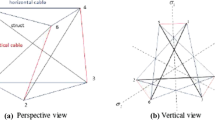Abstract
A high-efficiency form-finding algorithm is crucially important for finding a stabilized tensegrity structure. In this paper, a modified Broyden-Fletcher-Goldfarb-Shanno noise-tolerant zeroing neural network (MBFGS-NTZNN) form-finding approach is developed and investigated for the form-finding problems of tensegrity systems. A modified BFGS algorithm (MBFGS) is employed to solve the irreversibility of the Hessian matrix, which could avoid the non-positive definite circumstance of the stiffness matrix. Additionally, the approach could be utilized to make a reduction in algorithm calculation complexity. Moreover, to find a group of suitable nodal coordinates, a zeroing neural network (ZNN) based NTZNN is considered to suppress the noise, which may include rounding errors and external disturbance during the form-finding process. Besides, the 0-stable and global convergence under the pollution of noise are verified. Eventually, numerical simulations and an application example are conducted to ascertain the superiority and availability of the MBFGS-NTZNN algorithm in the fields of form-finding.








Similar content being viewed by others

References
Arsenault M, Gosselin CM (2005) Kinematic, static, and dynamic analysis of a planar one-degree-of-freedom tensegrity mechanism. J Mech Des 127:1152–1160
Arsenault M, Gosselin CM (2006) Kinematic, static and dynamic analysis of a planar 2-DOF tensegrity mechanism. Mech Mach Theory 41(9):1072–1089
Arsenault M, Gosselin CM (2006) Kinematic, static, and dynamic analysis of a spatial three-degree-of-freedom tensegrity mechanism. J Mech Des 128(5):1061–1069
Schek HJ (1974) The force density method for form finding and computation of general networks. Comput Methods Appl Mech Eng 3(1):115–134
Tran HC, Lee J (2009) Advanced form-finding of tensegrity structures. Comput Struct 88(3–4):237–246
Tran HC, Lee J (2011) Form-finding of tensegrity structures using double singular value decomposition. Eng Comput 29:71–86
Tran HC, Lee J (2011) Form-finding of tensegrity structures with multiple states of self-stress. Acta Mech 222:131–147
Lee S, Lee J (2011) Advanced automatic grouping for form-finding of tensegrity structures. Struct Multidiscip Optim 55:959–998
Lee S, Gana BS, Lee J (2016) A fully automatic group selection for form-finding process of truncated tetrahedral tensegrity structures via a double-loop genetic algorithm. Compos B 106(1):308–315
Lee S, Lee J, Kang JW (2017) Results of generalized equilibrium path from form-finding of tensegrity structure. Int J Steel Struct 17(3):1225–1231
Estrada GG, Bungartz HJ, Mohrdieck C (2006) Numerical form-finding of tensegrity structures. Int J Solids Struct 43(22–23):6855–6868
Cai J, Feng J (2015) Form-finding of tensegrity structures using an optimization method. Eng Struct 104(1):126–132
Cai J, Wang X, Deng X, Feng J (2018) Form-finding method for multi-mode tensegrity structures using extended force density method by grouping elements. Compos Struct 187(1):1–9
Yuan X, Ma S, Jiang S (2017) Form-finding of tensegrity structures based on the Levenberg-Marquardt method. Comput Struct 192:171–180
Sun Z, Li H, Wang J, Tian Y (2017) Two modified spectral conjugate gradient methods and their global convergence for unconstrained optimization. Int J Comput Math 95(10):2082–2099
Li Y, Feng XQ, Cao YP, Gao H (2010) A Monte Carlo form-finding method for large scale regular and irregular tensegrity structures. Int J Solids Struct 47(14–15):1888–1898
Zhang L, Li Y, Cao Y, Feng X (2014) Stiffness matrix based form-finding method of tensegrity structures. Eng Struct 58:36–48
Zhang Y, Zhang YY, Chen D, Xiao Z, Yan X (2016) From Davidenko method to Zhang dynamics for nonlinear equation systems solving. IEEE Trans Syst, Man, Cybern: Syst 47(11):2817–2830
Xiao L, Zhang Y (2011) Zhang neural network versus gradient neural network for solving time-varying linear inequalities. IEEE Trans Neural Netw 22(10):1676–1684
Zhang Y, Ma W, Cai B (2009) From Zhang neural network to newton iteration for matrix inversion. IEEE Trans Circuits Syst I Regul Pap 56(7):1405–1415
Xiao L, Li S, Li K, Jin L, Liao B (2020) Co-design of finite-time convergence and noise suppression: A unified neural model for time varying linear equations with robotic applications. IEEE Trans Syst, Man, Cybern: Syst 50(12):5233–5243
Zhang Y, Li W, Guo D, Ke Z (2013) Different Zhang functions leading to different ZNN models illustrated via time-varying matrix square roots finding. Expert Syst Appl 40(11):4393–4403
Zhang Y, Mu B, Zheng H (2013) Link between and comparison and combination of Zhang neural network and quasi-Newton BFGS method for time-varying quadratic minimization. IEEE Trans Cybern 43(2):490–503
Qiu B, Zhang Y, Yang Z (2018) New discrete-time ZNN models for least-squares solution of dynamic linear equation system with time-varying rank-deficient coefficient. IEEE Trans Neural Netw Learn Syst 29(11):1–10
Jin L, Liufu Y, Lu H, Zhang Z (2020) Saturation-allowed neural dynamics applied to perturbed time-dependent system of linear equations and robots. IEEE Transactions on Industrial Electronics. to be published
Cao Y, Huang J (2020) Neural-network-based nonlinear model predictive tracking control of a pneumatic muscle actuator-driven exoskeleton. IEEE/CAA J Autom Sinica 7(6):1478–1488
Jin L, Yan J, Du X, Xiao X, Fu D (2020) RNN for solving time-variant generalized Sylvester equation with applications to robots and acoustic source localization. IEEE Trans Industr Inf 16(10):6359–6369
Jin L, Zhang Y (2015) Discrete-time Zhang neural network for online time-varying nonlinear optimization with application to manipulator motion generation. IEEE Trans Neural Netw Learn Syst 26(7):1525–1531
Zhang J, Jin L, Yang C (2021) Distributed cooperative kinematic control of multiple robotic manipulators with improved communication efficiency. IEEE/ASME Transactions on Mechatronics
Wei L, Jin L, Yang C, Chen K, Li W (2019) New noise-tolerant neural algorithms for future dynamic nonlinear optimization with estimation on Hessian matrix inversion. IEEE Transactions on Systems, Man, and Cybernetics: Systems. to be published
Sun Z, Li F, Jin L, Shi T, Liu K (2020) Noise-tolerant neural algorithm for online solving time-varying full rank matrix Moore-Penrose inverse problems: a control-theoretic approach. Neurocomputing 413(6):158–172
Sun Z, Shi T, Wei L, Sun Y, Liu K, Jin L (2019) Noise-suppressing zeroing neural network for online solving timevarying nonlinear optimization problem: A control-based approach. Neural Comput Appl 32:11505–11520
Shi T, Tian Y, Sun Z, Liu K, Jin L, Yu J (2021) Noise-tolerant neural algorithm for online solving Yang-Baxter-type matrix equation in the presence of noises: A control-based method. Neurocomputing 424:84–96
Sun Z, Liu Y, Wei L, Liu K (2020) Two DTZNN models of O(\({\tau ^4}\)) pattern for online solving dynamic system of linear equations: Application to manipulator motion generation. IEEE Access 99(1–1):36624–36638
Yuan Y (1991) A modified BFGS algorithm for unconstrained optimization. IMA J Numer Anal 11(3):326–332
Li D, Fukushima M (2001) A modified BFGS method and its global convergence in nonconvex minimization. J Comput Appl Math 129(1–2):15–35
Zhang T, Tran M, Huang H (2018) Design and experimental verification of hip exoskeleton with balance capacities for walking assistance. IEEE/ASME Trans Mechatron 23(1):274–285
Pi M, Li Z, Li Q, Kan Z, Xu C, Kang Y, Su C, Yang C (2020) Biologically inspired deadbeat control of robotic leg prostheses. IEEE/ASME Trans Mechatron 25(6):2733–2742
Liu X, Wang Q (2020) Real-time locomotion mode recognition and assistive torque control for unilateral knee exoskeleton on different terrains. IEEE/ASME Trans Mechatron 25(6):2722–2732
Yin X, Zhang L, Xu J (2020) Constructing various simple polygonal tensegrities by directly or recursively adding bars. Compos Struct 234(15):111639
Liu S, Li Q, Wang P, Guo F (2020) Kinematic and static analysis of a novel tensegrity robot. Mech Mach Theory 149(3):103788
Vega GC, Schorr P, Kaufhold T, Zentner L, Zimmermann K, Böhm V (2020) Influence of elastomeric tensioned members on the characteristics of compliant tensegrity structures in soft robotic applications. Procedia Manuf 52:289–294
Liu M, Chen L, Du X, Jin L, Shang M (2021) Activated gradients for deep neural networks. IEEE Trans Neural Networks Learn Syst 1–13. https://doi.org/10.1109/TNNLS.2021.3106044
Liu M, Li H, Li Y, Jin L, Huang Z (2021) From WASD to BLS with application to pattern classification. Appl Soft Comput 108:107455. https://doi.org/10.1016/j.asoc.2021.107455
Author information
Authors and Affiliations
Corresponding author
Ethics declarations
Conflict of Interest
The authors declare that there is no conflict of interests regarding the publication of this paper.
Additional information
Publisher's Note
Springer Nature remains neutral with regard to jurisdictional claims in published maps and institutional affiliations.
The work is supported in part by the National Natural Science Foundation of China under Grants 61873304, in part by the China Postdoctoral Science Foundation Funded Project under Grant 2018M641784 and 2019T120240, and also in part by the Key Science and Technology Projects of Jilin Province, China, Grant Nos. 20200201291JC.
Rights and permissions
About this article
Cite this article
Sun, Z., Zhao, L., Liu, K. et al. An advanced form-finding of tensegrity structures aided with noise-tolerant zeroing neural network. Neural Comput & Applic 34, 6053–6066 (2022). https://doi.org/10.1007/s00521-021-06745-6
Received:
Accepted:
Published:
Issue Date:
DOI: https://doi.org/10.1007/s00521-021-06745-6



